What is the primary break in basketball
The primary break is a basketball offensive strategy as well as the initial fast break phase of transition offense and its general purpose is to create quick scoring opportunities against an outnumbered defense, usually within the first two or three seconds after gaining possession of the basketball.
Why is the primary break a potentially effective strategy
The primary break is a potentially effective strategy because it is simply one of the easiest methods for generating opportunities to score, particularly near the basket, against a defense that is unprepared or incapable of adequately stopping the primary break.
Essentially, with the primary break, there is no need to implement any set plays or other types of basketball offense such as continuity offense or motion offense.
Instead, the main emphasis of the primary break is to get the ball down the court with at least two offensive players and score quickly against a defense that typically has a numbers disadvantage (i.e. less defenders than the number of offensive players).
What are typical situations in which the primary break could be executed
The typical situations in which the primary break could be executed are when Team A (one particular team currently on offense) misses a shot, makes a shot, or commits a live-ball turnover during their own offensive possession.
Afterwards, Team B (one particular team currently on defense) gains possession of the ball. At that exact moment, Team B transitions into the new offensive team (i.e. transition offense) and then, Team B has the opportunity to execute the primary break, generally within the first two or three seconds after gaining possession of the ball.
Missed shot occurs
If Team A (currently on offense) misses a shot at the rim (or in certain instances, the shot gets blocked), then Team B (currently on defense) could grab the defensive rebound.
After that happens, Team B (currently in transition offense) could then initiate the primary break to get the ball quickly into the frontcourt before Team A can get back to set up their own complete defensive formations.
Team B could accomplish this by utilizing passing skills such as the pitch ahead pass which could be used to throw the ball ahead of the majority of Team A’s defenders.
Afterwards, Team B could score on the defense, typically near the basket or from the perimeter, particularly from three-point range.
Additionally, in a few situations, a player could execute what is generally known as a one-man fast break by grabbing a rebound themselves (or possibly receiving the ball from another teammate in the backcourt), dribbling the length of the court, and then scoring on the defense via a layup or dunk.
Made shot occurs
If Team A makes a shot, then Team B could get the ball out of the net and quickly inbound it, preferably to the point guard or another good passer.
Furthermore, it should be noted that at this point, Team A is now on defense while Team B has transitioned to offense.
Next, Team B could have one or more offensive players sprint down the court, particularly near the wings.
Afterwards, if Team A does not sprint back into the frontcourt quickly enough to stay in front of the offensive players, then Team B could possibly pass the ball down the court and score near the basket or from the perimeter.
This type of scenario is also one of the primary scoring options within the numbered fast break.
Live-ball turnover occurs
If Team A commits a live-ball turnover by executing a bad pass which gets intercepted or Team A does not sufficiently protect the ball due to poor ball handling (such as unnecessary dribble moves or improper triple threat positioning), which gives Team B the opportunity to steal the ball, then Team A will instantly transition into defense while Team B (who now has possession of the ball) transitions into offense.
From that point, Team A would most likely not be able to sprint into the frontcourt to adequately protect the basket or stop the offensive advantage and primary break of Team B.
When that occurs, Team B will almost certainly be able to score with an uncontested layup/dunk or in some instances, take a wide open jump shot.
What is the general difference between primary break and secondary break
Generally speaking, the primary break typically occurs within the first two or three seconds of transition offense while the secondary break, as the name implies, occurs secondary to (or after) the primary break beyond the initial two to three seconds.
Also, with the primary break, there is fundamentally more offensive players in the frontcourt than there are defensive players to limit or prevent scoring opportunities.
On the other hand, with the secondary break, all of the defenders are able to sprint back into the frontcourt, thereby eliminating the potential numbers advantage provided to the offensive team during the primary break.
However, during the secondary break, the offensive team could still score quickly, similar to the primary break, by taking advantage of potential mismatches, especially near the basket, or other notable issues such as poor defensive closeouts, particularly near the perimeter.
What are examples of scoring options within the primary break
Example 1
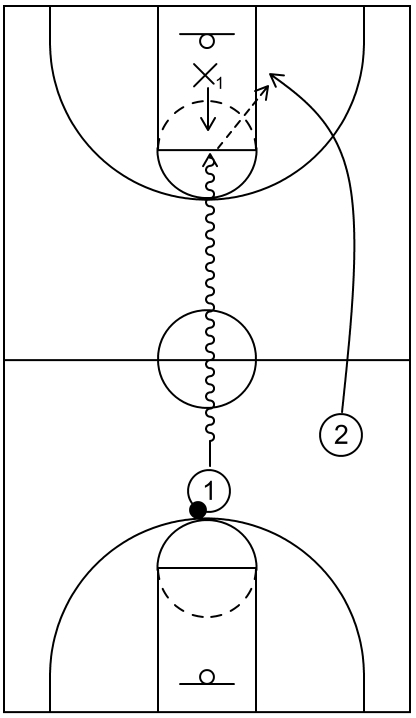
This is an example of scoring options within the primary break in which offensive players 1 and 2 have a numbers advantage against X1, a defender that protects the basket. In other words, it is a 2 on 1 fast break opportunity.
To demonstrate, 1 dribbles with speed down the middle of the court while 2 sprints towards the frontcourt wing area. Following that, once 2 gets below the free throw line extended area, 2 then begins to cut in towards the basket.
At this point, if X1 stays near the rim, then 1 could take the mid-range jump shot near the free throw line. Also, if 1 happens to miss the shot, then 2 could grab the potential offensive rebound and try to score near the rim again.
On the other hand, if X1 steps up in an attempt to put defensive pressure on 1 as shown on the diagram (this is basically a mistake by the defender), then 2 could receive the ball from 1 and score near the rim with a layup/dunk.
Example 2
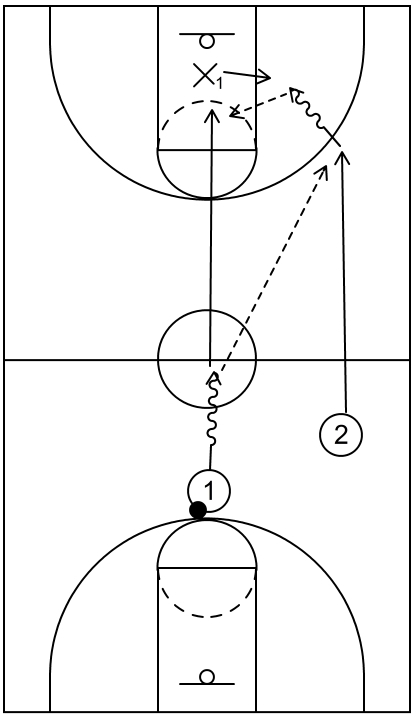
This is another example of scoring options within the primary break in which offensive players 1 and 2 have an advantage against X1 protecting the basket. Similar to the previous example, it is another 2 on 1 fast break opportunity.
To start, 1 dribbles toward the half court line while 2 sprints toward the frontcourt wing. Afterwards, 2 receives the ball via the pitch ahead pass from 1.
Next, 2 dribbles toward the basket while 1 sprints down the middle. Also, as that action happens, X1 slides over slightly towards the ball so that 2 would not have such an easy layup at the rim.
However, this allows 1 to receive the ball again via the short pass by 2. From there, 1 could score at the rim.
Example 3
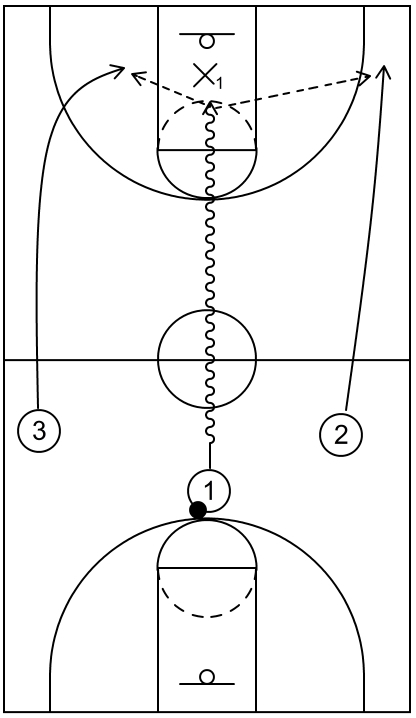
This is an example of scoring options within the primary break and it is a 3-on-1 fast break opportunity because offensive players 1, 2, and 3 have an advantage over X1.
To demonstrate, 1 dribbles down the middle of the court while 2 and 3 initially run down the sidelines. Next, after getting below the free throw line extended areas, 2 cuts to the right side corner while 3 cuts to the basket.
At this point, 3 could receive the ball and score near the rim or 2 could receive it instead and take the open three-point jump shot. Also, in some instances, 1 could keep the ball and score themselves if there is an opening to do so.
Essentially, X1 should not be able to guard three people (at least with any viable effect) so one of those three should be able to score or at bare minimum, execute a field goal attempt.
Example 4
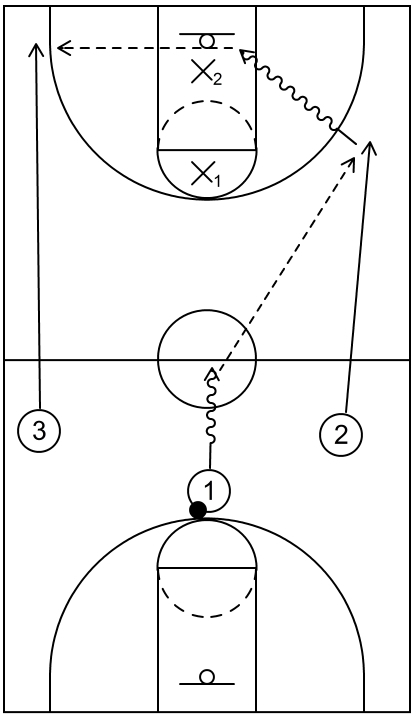
This is an example of scoring options within the primary break and it is also a 3-on-2 fast break because offensive players 1,2, and 2 have a numbers advantage over defenders X1 and X2.
To begin, 1 dribbles down the middle of the court while 2 and 3 initially run down the sidelines. For this case (unlike the previous 3-on-1 example), X1 is protecting the nail near the free throw line/high post area.
This nail protection essentially means that 1 cannot easily use dribble penetration to drive towards the basket as with the 3-on-1 example.
Instead, 2 could receive the ball near the right side wing via the pitch ahead pass by 1. Following that, 2 could dribble towards the basket and as that occurs, 3 could cut to the left side corner.
From that point, 2 could either score at the rim or as an alternative option, 3 could receive the ball via the drift pass from 2. Afterwards, 3 could take the open jump shot.
Example 5
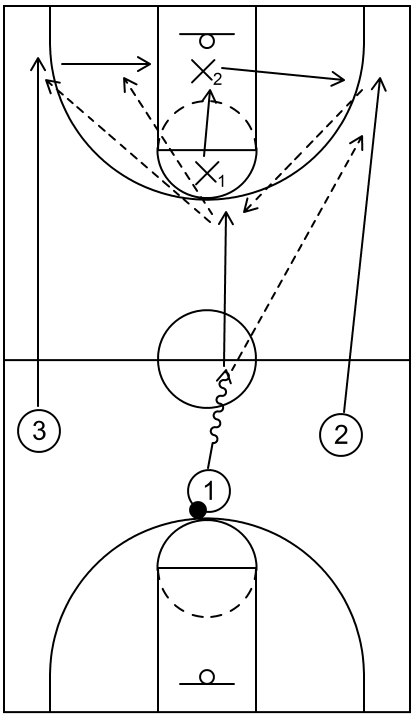
This is an example of scoring options within the primary break and it is also another 3-on-2 numbers advantage for the offensive team. To start, 1 dribbles down the middle of the court while 2 and 3 initially run towards the corners in the frontcourt.
From there, 2 receives the pitch ahead pass from 1 (similar to the previous diagram), but this time, X2 executes a defensive closeout to prevent a potential uncontested jump shot.
When that occurs, X1 drops back to protect the basket while 1 cuts to the top. In other words, X2 does not want a jump shot from 2 but X1 assumes (or knows) that 1 is not a good perimeter shooter. Therefore, X1 does not care if 1 takes a jump shot.
Next, 1 receives the ball from 2 and then 1 could take the jump shot if open. However, if the assumption of X1 is true and 1 is a below average perimeter shooter, then 3 could receive the ball from 1 instead.
If 3 is a good perimeter shooter, then 3 could receive the ball near the corner and then take the open three-point jump shot.
On the other hand, if 3 is either a poor perimeter shooter or 3 is an above average rim finisher, then 3 could cut to the basket from the corner, receive the ball, and then score via a layup/dunk.
Affiliate Disclosure: I may earn a commission on qualifying purchases made through the links below.
What is an example of a primary break basketball drill
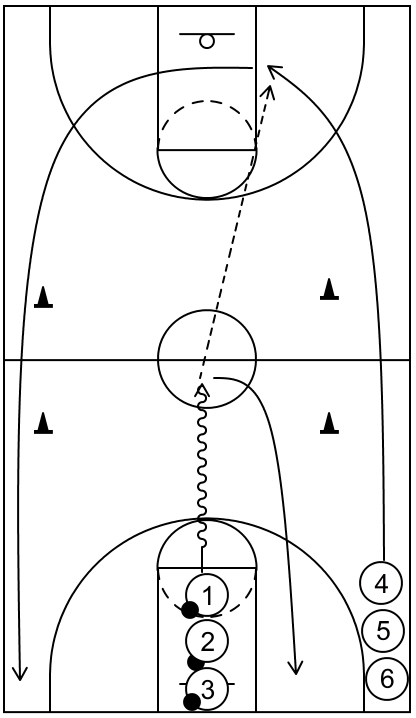
This is an example of a primary break 2-on-0 basketball drill that seeks to develop the pitch ahead pass, full court conditioning, speed, catching with two hands, and finishing at the rim.
It is derived from insights within Open Practice: Man-to-Man & Zone Offenses by Brenda Frese.
Also, the numbers on the diagrams are not representative of standard basketball positions for the players. Instead, those numbers are mainly used for demonstration purposes.
So, player 1 is not necessarily a point guard, player 2 is not necessarily a shooting guard, and so forth.
To set up the drill, one group of players, each in possession of a basketball, form a line in the key starting below the free throw line.
At the same time, another group of players form a second line near the wing/corner area that is to the right of the other line of players.
Also, the players in the second line should position themselves slightly above the first line of players.
Furthermore, it is possible to utilize two cones on each side of the court (a total of four cones) about 3 to 4 feet from the half court line that serve as markers, particularly for the players in the second line.
For the first group of players, their primary purpose is to dribble the ball once or twice straight down the middle inside of the cones, followed by a pitch ahead pass to the one of the other players in the opposite line.
For the second group of players, their main objective is to run down the court outside of the cones, catch the ball via the pitch ahead pass, and score at the rim via layups.
To begin, a coach could blow the whistle or give some other type of verbal cue such as by saying “Go!” and when that occurs, 4 sprints as quickly as possible towards the frontcourt.
Immediately after 4 begins the sprint, 1 dribbles once or twice towards the frontcourt. As that occurs, 4 should now be in the frontcourt close to the three-point arc.
From there, 4 should continue to sprint towards the basket at a slight angle with hands ready to receive the ball. Next, 1 should execute the pitch ahead pass just before crossing the half court line into the frontcourt.
Following that, 4 should catch the ball and score at the rim, preferably with a layup. It should also be noted that if 4 runs as fast as possible, then 4 should not need to dribble the ball, prior to shooting the layup.
However, it should also be mentioned that if players are working on specific skills or the two groups are based on roles/positions such as guards in the first line with wings/post players in the second line, then each player, based on their role/position could simply go back to the same line as previously.
Moreover, in terms of rebounding after the layup, a team manager or assistant coach at the nearest baseline could grab the ball once it goes through the basket ring, pass it to another team manager or assistant coach near the left sideline that is opposite the players in the second line, and then pass it again to a player at the end of the first line.
If that is not viable, then 4 could simply grab the ball after making the layup, keep possession of it while cutting on the outside of the cones that are opposite of the second line, and then pass the ball to a player at the end of the first line.
After 1 and 4 complete the drill, 1 could turn around and move to the back of the second line while 4 stays on the outside of the opposite pair of cones, going towards the back of the first line. From there, 2 and 5 could proceed to execute the drill again followed by 3 and 6.